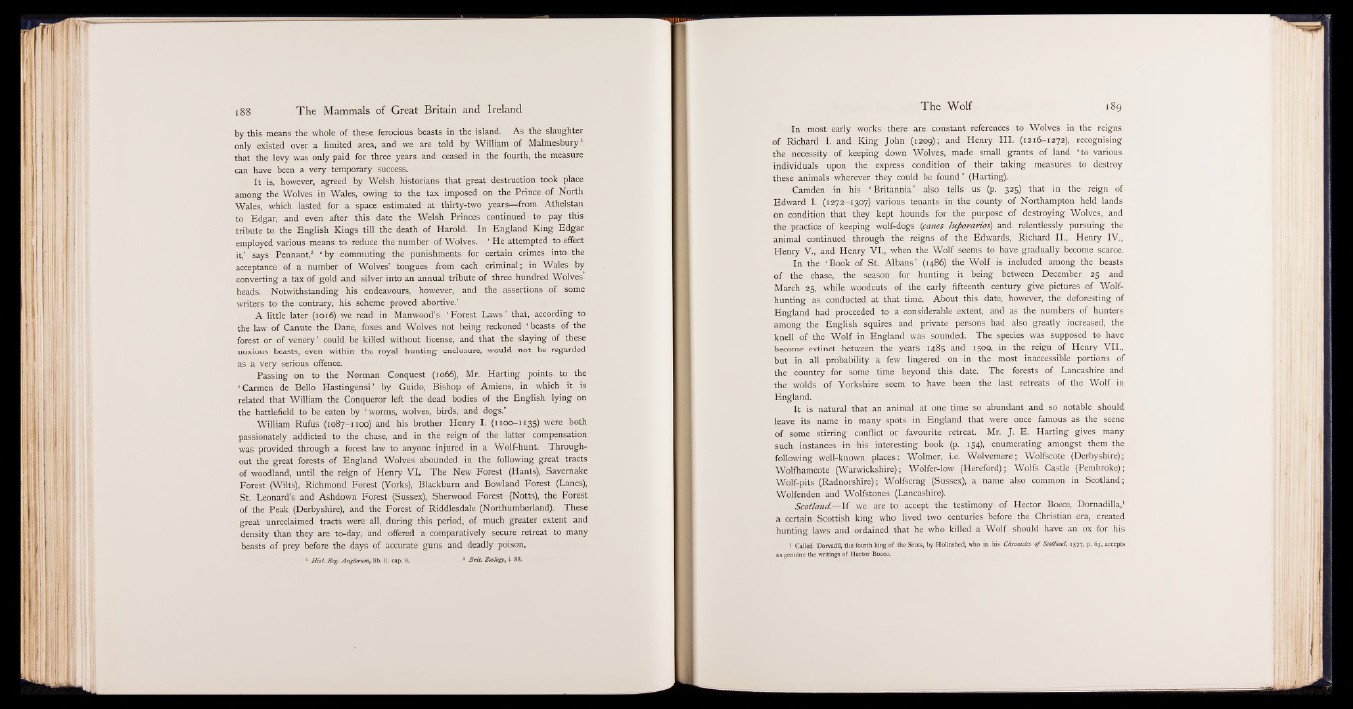
by this means the whole of these ferocious beasts in the island. As the slaughter
only existed over a limited area, and we are told by William of Malmesbury1
that the levy was only paid for three years and ceased in the fourth, the measure
can have been a very temporary success.
It is, however, agreed by Welsh historians that great destruction took place
among the Wolves in Wales, owing to the tax imposed on the Prince of North
Wales, which lasted for a space estimated at thirty-two years— from Athelstan
to Edgar, and even after this date the Welsh Princes continued to pay this
tribute to the English Kings till the death of Harold. In England King Edgar
employed various means to reduce the number of Wolves. 1 He attempted to effect
it,’ says Pennant,2 ‘ by commuting the punishments for certain crimes into the
acceptance of a number of Wolves’ tongues from each criminal; in Wales by
converting a tax of gold and silver into an annual tribute of three hundred Wolves
heads. Notwithstanding his endeavours, however, and the assertions of some
writers to the contrary, his scheme proved abortive.’
A little later (1016) we read in Manwood’s ‘ Forest Laws ’ that, according to
the law of Canute the Dane, foxes and Wolves not being reckoned ‘ beasts of the
forest or of venery’ could be killed without license, and that the slaying of these
noxious beasts, even within the royal hunting enclosure, would not be regarded
as a very serious offence.
Passing on to the Norman Conquest (1066), Mr. Harting points to the
‘ Carmen de Bello Hastingensi ’ by Guido, Bishop of Amiens, in which it is
related that William the Conqueror left the dead bodies of the English lying on
the battlefield to be eaten by ‘ worms, wolves, birds, and dogs.’
William Rufus (1087-1100) and his brother Henry I. (1100-1135) were both
passionately addicted to the chase, and in the reign of the latter compensation
was provided through a forest law to anyone injured in a Wolf-hunt. Throughout
the great forests of England Wolves abounded in the following great tracts
of woodland, until the reign of Henry VI. The New Forest (Hants), Savernake
Forest (Wilts), Richmond Forest (Yorks), Blackburn and Bowland Forest (Lancs),
St. Leonard’s and Ashdown Forest (Sussex), Sherwood Forest (Notts), the Forest
of the Peak (Derbyshire), and the Forest of Riddlesdale (Northumberland). These
great unreclaimed tracts were all, during this period, of much greater extent and
density than they are to-day, and offered a comparatively secure retreat to many
beasts of prey before the days of accurate guns and deadly poison.
1 Hist. Reg. Angiorum, lib. ii. cap. 8. 2 B rit. Zoology, i. 88.
In most early works there are constant references to Wolves in the reigns
of Richard I. and King John (1209); and Henry III. (1216-1272), recognising
the necessity of keeping down Wolves, made small grants of land ‘ to various
individuals upon the express condition of their taking measures to destroy
these animals wherever they could be found ’ (Harting).
Camden in his ‘ Britannia’ also tells us (p. 325) that in the reign of
Edward I. (1272-1307) various tenants in the county of Northampton held lands
on condition that they kept hounds for the purpose of destroying Wolves, and
the practice of keeping wolf-dogs (canes luporarioi) and relentlessly pursuing the
animal continued through the reigns of the Edwards, Richard II., Henry IV.,
Henry V., and Henry VI., when the Wolf seems to have gradually become scarce.
In the ‘ Book of St. Albans’ (i486) the Wolf is included among the beasts
of the chase, the season for hunting it being between December 25 and
March 25, while woodcuts of the early fifteenth century give pictures of Wolfhunting
as conducted at that time. About this date, however, the deforesting of
England had proceeded to a considerable extent, and as the numbers of hunters
among the English squires and private persons had also greatly increased, the
knell of the Wolf in England was sounded. The species was supposed to have
become extinct between the years 1485 and 1509, in the reign of Henry VII.,
but in all probability a few lingered on in the most inaccessible portions of
the country for some time beyond this date. The forests of Lancashire and
the wolds of Yorkshire seem to have been the last retreats of the Wolf in
England.
It is natural that an animal at one time so abundant and so notable should
leave its name in many spots in England that were once famous as the scene
of some stirring conflict or favourite retreat. Mr. J. E. Harting gives many
such instances in his interesting book (p. 154), enumerating amongst them the
following well-known places: Wolmer, i.e. Wolvemere; Wolfscote (Derbyshire);
Wolfhamcote (Warwickshire); Wolfer-low (Hereford); Wolfs Castle (Pembroke);
Wolf-pits (Radnorshire); Wolfscrag (Sussex), a name also common in Scotland;
Wolfenden and Wolfstones (Lancashire).
Scotland.— If we are to accept the testimony of Hector Boece, Dornadilla,1
a certain Scottish king who lived two centuries before the Christian era, created
hunting laws and ordained that he who killed a Wolf should have an ox for his
1 Called Dorvadil, the fourth king of the Scots, by Holinshed, who in his Chronicles o f Scotland, 1577, p. 63, accepts
as genuine the writings of Hector Boece.